Farm mechanization: By the people, for the people
Total Views |
Monsoon was in full swing and farm operations were at the peak when Sunil Shinde lost a bullock from his pair. It was a shock and a major problem for completing farm operations. During season, it was difficult to ask a fellow farmer to share his bullock pair. But Sunil did not lose hope. He developed an equipment from available material which uses single bullock and completed his farm operations. This gave him a new insight about farm equipment. He went on to develop 20 plus such implements which are useful for small farmers. Sunil Shinde is a small farmer from Ghansangavi tahsil, Jalna District, Maharashtra. He has continued his efforts to develop new equipments, modified versions of available implements which can help farmers in distress. Turning difficult situations into an opportunity is an important quality of vibrant society with fighting spirit. Sunil’s efforts show this very basic trait of the society. At the same time, it highlights plight of small farmers and advocates need of implements useful for small farmers.
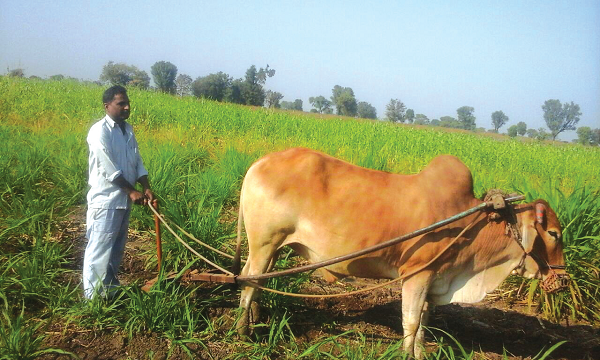
Missing focus in mechanization
Agriculture development is directly linked with kinds of implements and technologies used. From ancient times, people were developing improving implements. Farm mechanization is useful for farmers in various ways. It helps in input saving. It can reduce 15-20% of seed and fertilizer used and helps to increasing cropping intensity. It increases efficiency. It saves farm operation time and also reduces harvesting losses. Mechanization helps to convert uncultivable land into cultivable land. It reduces drudgery of women and increases safety during operations. It also helps to reduce labor costs and operations become manageable during labor crunch.
Farm mechanization has been a focus point in agricultural country like India. One of the key indicators used by policy makers to measure growth of mechanization is the use of tractors for number of hectares. NABARD sectoral paper in 2018 states that from 1971 to 2018, tractor power share has increased from 7% to 45%; whereas animal power share has decreased from 45% to 5%. Tractor penetration increased from one per 150 hectares to 1 per 30 hectares. We also witnessed high land fragmentation during same period. Number of small and marginal farmers also increased substantially in these years. However, penetration similar to tractor was not achieved in other farm equipment’s which are especially useful for small and marginal farmers.
Statistics related to farm mechanization in various operations related to farming is interesting and needs a closer look. It ranges from 29% in seeding & planting to 70% in harvesting and thrashing of wheat and rice. At the same time mechanization in harvesting and thrashing of other crops is not more than 5%. These other crops include millets, pulses, oil seeds which are mostly grown in hilly regions, tribal areas, arid & semi-arid areas. This reveals that our mechanization policies were not appropriate for majority small and marginal farmers, women farmers and marginalized areas where infrastructure is poor.
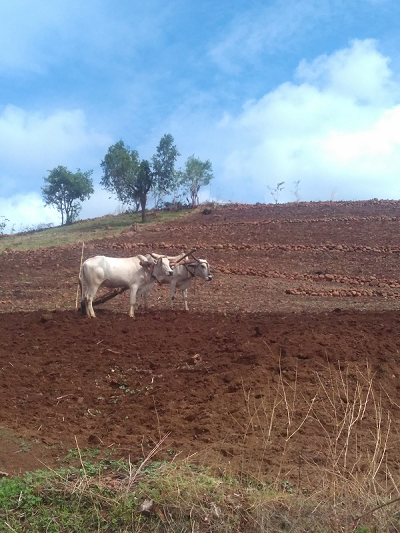
On ground, farmers are facing multiple issues. Climate change has become reality and every year showing its new ávatars’. While we discuss melting of ice on arctic, farmers are facing change in rainfall, long dry spells, shorter time to complete operations, increased pest attacks etc. Other problems like labor shortage and high drudgery especially for women farmers are increasing. Close data regarding mechanization shows that % of mechanization is very low in operations carried out by women. High drudgery affects health of women engaged into farming. At the same time farming provides highest employment to women in the country.
Various agriculture universities and research institutes are working on implements for small and marginal farmers. But lab to land system is not strong. So, they remain into labs and showcases. Linkage with production companies is also poor. There is limited interest in these small implements as profit margin are less and work is more.
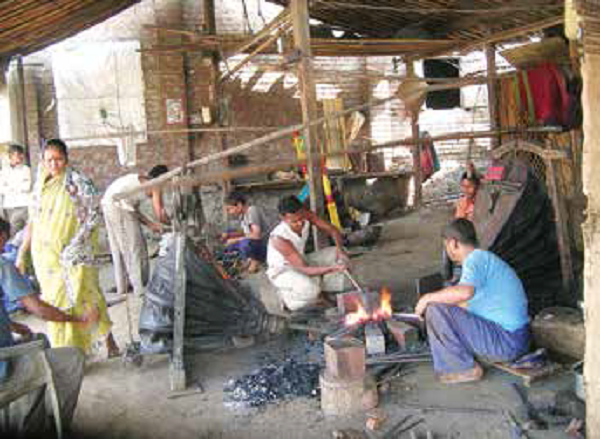
We did have our local systems to produce, develop implements. But in last 70 years, government has sidelined traditional blacksmith system which was backbone of Indian agriculture. One can see gradual degradation of the same. Studies by Suruchi, Bardoli in Gujarat show that traditional blacksmiths are rapidly changing their occupations.
This situation demands retrospection. Was copying western model solved our problems or increased them? Did our effort actually help the majority farming community in the country? Our needs are different. Our crops, our climate, our geography and our people are different. We should have developed our own policy for farm mechanization rather than promoting tractorisation. One Size fits all is not suitable for India. But even after 70 years, it seems that we are still not learning. Today we are promoting group farming so that we can effectively use these tractors when most of remote hilly areas cannot use tractors for various geographical reasons. Also use of tractor is not suitable for shallow soil areas and deep ploughing by tractors is creating new problems.
Government also realized this and taking few steps. But it is far less than what is required. If we carefully look at various schemes, major portion is given to subsidy on tractor and tractor-based equipment’s and small amount is provided to implements useful for small and marginal farmers.
For the people, by the people: effort from grassroots
While policy makers continue to promote western model, society on its own was trying to find solutions. Many artisans , grassroots workers tried to develop implements for small and marginal farmers. They worked with available material, mostly dependent on scrap material, with limited technical support and financial backing.
Shri Dada Wadekar is a craftsman from Thane district of Maharashtra. He has been working on improvement in implements for small farmers for the last 40 years. He works in his own lab cum garage. He has developed more than 40 small implements over the years. He has developed a set of 15 implements which are useful for most small and marginal farmers. He even thought about women who prefer working with left-hand in farm and developed a sickle for them.
Kisan suvidha Kendra is a small implement bank that cost minimum Rs. 40000/- It provides implements on nominal rent. The key benefit of such effort is to reduced fear of using implements. The focus of small bank is on small implements mainly used by women in cultivation operations and post-harvest activities. It reduces investment in implements by each family, reduces labour cost, helps to complete operations in times, and reduces drudgery and loss in produce. As per need, variety and number of implements can be increased. It can also give good returns over the period.
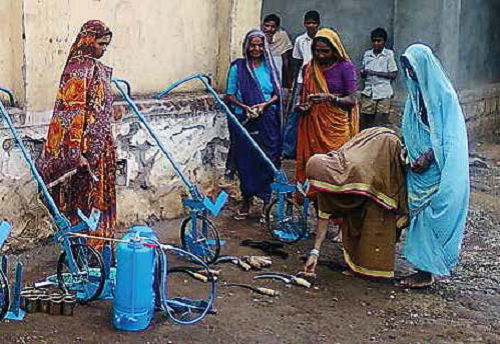
Many such grassroots innovators are working across the state and country. A desk-based study of published literature from newspapers by YOJAK found more than 40 such innovators across Maharashtra. They are working on a number of farming operation problems. The range is amazing. It covers a sickle useful for left-handers to solar operated sprayer and from small bamboo-based storage structures to low cost cold storages.
Suruchi Bardoli has been working on strengthening traditional blacksmith system in Dang, Tapi and other districts of Gujarat for last few years. They are supporting with improved designs, building their capacities for quality material, finishing of products etc. They have also worked on reducing the cost of overall process and developed improved equipments for blacksmiths.
Palle Srujana is an organization working on identifying and supporting grassroots innovators. Palle srujana means Rural Creations. They have identified more than 200 innovators. Among those, 13 got Rashtrapati Awards and 2 got a Padma Shree for their work. The organization has helped 25 innovators to patent their device. These innovators have collectively generated a turnover close to Rs. 4 crores and more than 5 lakh families benefited by their efforts. Shodha Yatra was being organized each year to identify these innovators. (http://www.pallesrujana.org/index.html) Palle srujana is kind of incubator for these rural artisans and innovators.
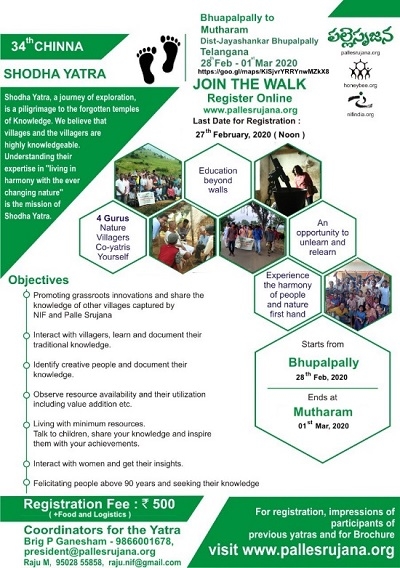
Inspiration behind local innovations is different for each innovator and is not about money making for most of the time. Sunil Shinde’s inspiration was his individual problem which also coincides with the societal problem. Chintakindi Mallesham who got Padmashree for his innovation in Kanchipuram Saree machine was inspired to reduce his mother’s pain while making saree. Dada Wadekar was troubled with drudgery involving various activities. He decided to work on the issue. It became his life mission. There are youths who are also making Implement production and marketing as bread and butter activity
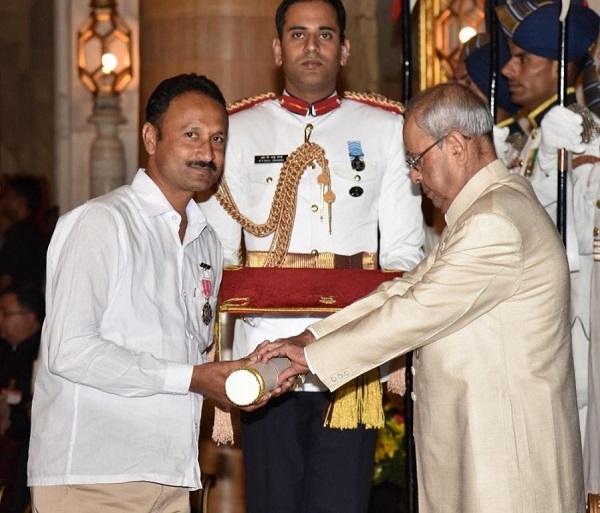
Use, improve and prosper
Society can also help in improving available implements and processing units. An example from Nandurbar is interesting and self-explanatory on the importance of involving people in technology development. Local NGO Dr. Hedgewar Seva Samiti introduced Mobile Rice Mill. The concept was unique. A mobile rice mill caters to 100 families, reduces drudgery of women, provides employment to one family and improves quality, quantity and return from rice crop.
Women who were operating these mills provided specific inputs on operational issues to the company which provided the mill. Company was also interested in improving mill and in 5 years a small, 50 kg per hr mill was transformed into 150kg per hr mill with improved efficiency. Such two-way dialogue has now created a successful enterprise in the region. It is a low investment high return service which improves overall return from major crop of the region. Today 23 such mills are operating and providing services to around 3000 families in Nandurbar district. All families have benefitted from these interventions. This shows the importance of collaboration between users and developers and a good feedback system can improve technology and returns in limited time.
Support system: Path to Antyodaya
We need to redefine mechanization priorities when more than 80% of our farmers belongs to small and marginal land holding category. Our policies should focus more on promotion of implements which can be affordable for small and marginal farmers, use minimum energy and /or multiple energy sources, possible to produce at grassroots level, reduce drudgery of women.
It is estimated that there are more than 100000 (1 lakh) local implement developers. Most of them are working with their own capacities. We need to recognise them as partners in mechanization. They need technical, financial support to improve efficiency and outreach. They require guidance in technological aspects like material used, design, weight etc. They need financial support in terms of soft loans, recognition as a small-scale industry, financial guidance. They need marketing and management support. Some policy support is also required especially in terms of testing of these implements, licensing, patenting to strengthen these efforts.
This provides excellent opportunity for CSR and corporate entities to share their capacities with local artisans, implement developers. Incubators, social venture funds can be established to support them. Pilots to support partnerships with farmer producer companies can be supported. Government can join hand with private sector for quality testing facilities.
Indian development thinking demands societal response for issues they are facing. Government has a role to support, facilitate these efforts. We have a grassroots level network. Support to this network from the Government and other stakeholders can lead to a robust farm mechanization system for small and marginal farmers. This is the path envisaged in Antyodaya.

